小学英语五年级语法知识汇总.pptx
- 格式:pptx
- 大小:33.93 KB
- 文档页数:4

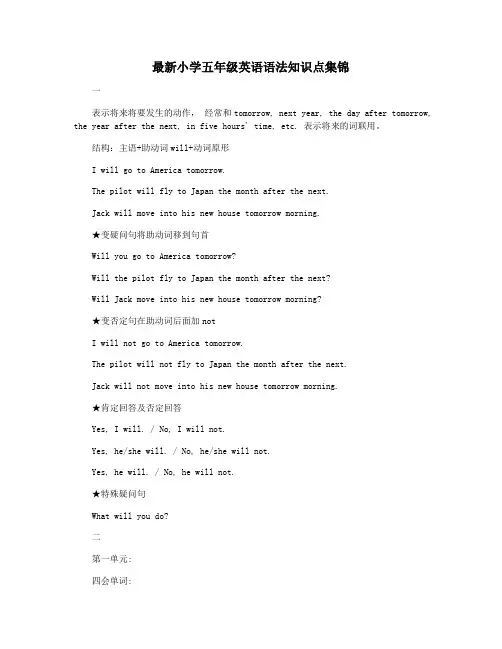
最新小学五年级英语语法知识点集锦一表示将来将要发生的动作,经常和tomorrow, next year, the day after tomorrow, the year after the next, in five hours' time, etc. 表示将来的词联用。
结构:主语+助动词will+动词原形I will go to America tomorrow.The pilot will fly to Japan the month after the next.Jack will move into his new house tomorrow morning.★变疑问句将助动词移到句首Will you go to America tomorrow?Will the pilot fly to Japan the month after the next?Will Jack move into his new house tomorrow morning?★变否定句在助动词后面加notI will not go to America tomorrow.The pilot will not fly to Japan the month after the next.Jack will not move into his new house tomorrow morning.★肯定回答及否定回答Yes, I will. / No, I will not.Yes, he/she will. / No, he/she will not.Yes, he will. / No, he will not.★特殊疑问句What will you do?二第一单元:四会单词:young年轻的 funny滑稽可笑的 tall高的 strong强壮的 kind和蔼的 old年老的short矮的 thin瘦的 Mr先生 like像;喜欢 strict严格的 smart聪明的;巧妙的active积极的;活跃的 quiet安静的;文静的 very很;非常 but但是缩写形式:who’s=who is what’s=what is he’s=he is she’s=she is重要句型:1.Who’s your art teacher?你们的美术老师是谁?----Mr Hu.胡先生.2.What’s he like?他长得什么样子? ----He’s short and thin.他又矮又瘦3.Is she young?她年轻吗?----Yes,she is/No, she isn’t.以前的知识:I have a new math teacher.我有一个新数学老师.小学三年级已经学过I have a pen.注意: 划线部分可以替换.第二单元:四会单词:Monday星期一 Tuesday星期二 Wednesday星期三Thursday星期四Friday星期五Saturday星期六Sunday星期日day天;日子have有;吃 on 在……时候 too也;太短语:do homework做作业 watch TV看电视 read books读书 What about?......怎么样?do housework做家务 play computer games玩电脑游戏重点句型:1. What day is it today?今天星期几?—It’s Monday.星期一.2. What do we have on Mondays?星期一我们有什么课?—We have English,science,computer and P.E.我们有英语课,科学,计算机跟体育课.3. What do you do on Saturdays?星期六你干什么?具体的某一天前用介词on,在具体的时间前,用介词at—I often do my homework.我通常做家庭作业.4. What about you?你呢?—I do my homework,too.我也是做家庭作业.第三单元:四会单词:eggplant茄子 fish鱼green beans青豆tofu豆腐potato土豆tomato西红柿for 为;给lunch中餐;午饭we我们tasty好吃的;可口的sweet甜的sour酸的fresh新鲜的salty咸的favourite最喜爱的;特别喜爱的fruit水果grape葡萄缩写形式:they’re=they are don’t=do not重点句型:1. What would you like for lunch?你午餐想吃什么?-----I’d like some tomatoes and mutton.我想吃一些西红柿跟羊肉.2. What’s your favourite fruit?你最喜欢的水果是什么?------/I like apples.我喜欢苹果.3.I don’t like grapes.我不喜欢葡萄.4.Bananas are my favourite.我最喜欢香蕉.第四单元一. 单词:empty the trash倒垃圾cook the meals 做饭water the flowers浇花sweep the floor扫地clean the bedroom打扫卧室make the bed铺床set the table摆餐具wash the clothes洗衣服do the dishes洗碗碟put away the clothes收拾衣服can’t = cannot不会;不能use a computer使用计算机二. 句子:1. I’m helpful! I can sweep the floor。


五年级英语语法知识汇总全内部编号:(YUUT-TBBY-MMUT-URRUY-UOOY-DBUYI-0128)英语语法知识汇总-五年级英语语法知识汇总一、词类:1、名词这里强调两点:不可数名词都默认为单数,所以总是用is 名词复数如何加后缀:2、人称代词和物主代词人称代词:有主格和宾格之分。
一般动词前用主格,动词后用宾格。
3、指示代词4、冠词有a、an、the。
a和an的区别:an用于元音音素(一般就是元音字母a、e、i、o、u)前,a用于辅音音素前。
二、否定句:be动词(am、is、are)+not、情态动词can+ not、助动词(do、does) + not如何将一个肯定的陈述句改为否定句:1、看句中有无be动词,如有,直接在be动词后+ not。
2、看句中有无情态动词,如有,直接在情态动词后+ not。
3、如上述二者都没有,就应用助动词+ not。
分四个步骤:(1)肯定陈述句中本来是没有助动词的,要加上去,位置在主语(某人或某物)后,动词前。
(2)确定助动词用do、does,根据句中动词,动词是原形的助动词就用do,动词是第三人称单数的助动词就用does,(3)在助动词后加not。
(4)原句中动词假如发生变化就要恢复成原形。
强调一点,有some的要考虑是否要用any。
三、一般疑问句。
如何将一个肯定的陈述句改为一般疑问句:1、看句中有无be动词,如有,把be动词提到句首即可。
2、看句中有无情态动词,如有,把情态动词提到句首即可。
3、如上述二者都没有,就应把助动提到句首。
分四个步骤:(1)肯定陈述句中本来是没有助动词的,要加上去,位置在主语(某人或某物)后,动词前。
I do like you. (2)确定助动词用do还是does,根据句中动词,动词是原形的助动词就用do,动词是第三人称单数的助动词就用does He does like you. (3)把助动词后提到句首。
Does he like you?(4)原句中动词假如发生变化就要恢复成原形。
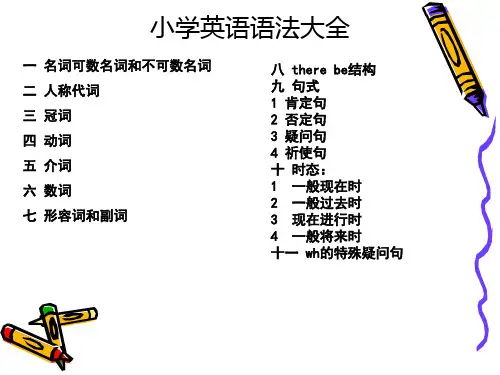
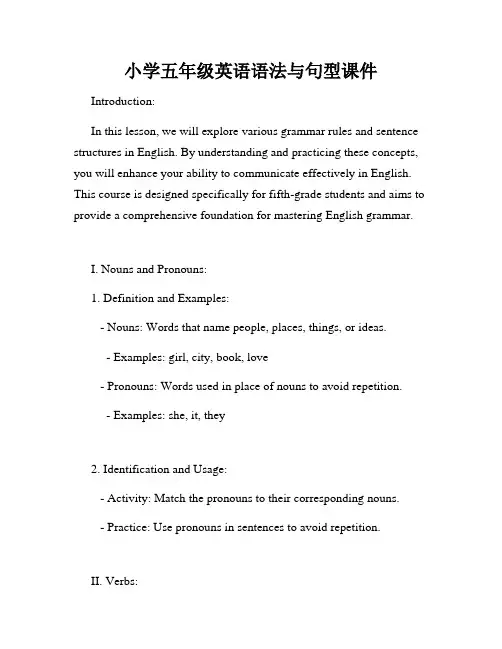
小学五年级英语语法与句型课件Introduction:In this lesson, we will explore various grammar rules and sentence structures in English. By understanding and practicing these concepts, you will enhance your ability to communicate effectively in English. This course is designed specifically for fifth-grade students and aims to provide a comprehensive foundation for mastering English grammar.I. Nouns and Pronouns:1. Definition and Examples:- Nouns: Words that name people, places, things, or ideas.- Examples: girl, city, book, love- Pronouns: Words used in place of nouns to avoid repetition.- Examples: she, it, they2. Identification and Usage:- Activity: Match the pronouns to their corresponding nouns.- Practice: Use pronouns in sentences to avoid repetition.II. Verbs:1. Definition and Examples:- Verbs: Words that express actions, states, or occurrences.- Examples: run, eat, sleep, dance2. Verb Tenses:- Present Tense: Actions happening now.- Example: The dog barks loudly.- Past Tense: Actions that have already happened.- Example: She ate an apple yesterday.- Future Tense: Actions that will happen in the future.- Example: We will watch a movie tomorrow.III. Adjectives and Adverbs:1. Definition and Examples:- Adjectives: Words that describe or modify nouns.- Examples: big, happy, red, beautiful- Adverbs: Words that describe or modify verbs, adjectives, or other adverbs.- Examples: quickly, very, well2. Comparison of Adjectives and Adverbs:- Comparative Form: Used to compare two things or actions.- Example: She is taller than her sister.- Superlative Form: Used to compare more than two things or actions.- Example: It is the best restaurant in town.IV. Sentence Structures:1. Subject and Predicate:- Subject: The main noun or pronoun that the sentence is about.- Example: The cat- Predicate: The part of the sentence that provides information about the subject.- Example: is sleeping on the mat.2. Simple Sentences:- Definition: A sentence with one subject and one predicate.- Example: The sun shines brightly.3. Compound Sentences:- Definition: Two simple sentences joined together by a coordinating conjunction.- Example: I like ice cream, but my brother prefers cake.4. Complex Sentences:- Definition: A sentence that contains an independent clause and one or more dependent clauses.- Example: Because it was raining, we stayed indoors.Conclusion:Understanding grammar and sentence structures is crucial for becoming proficient in English. By learning and practicing these concepts, you will be able to convey your thoughts and ideas accurately. Don't forget to review and reinforce your knowledge regularly to solidify your understanding. Keep up the good work, and happy learning!。



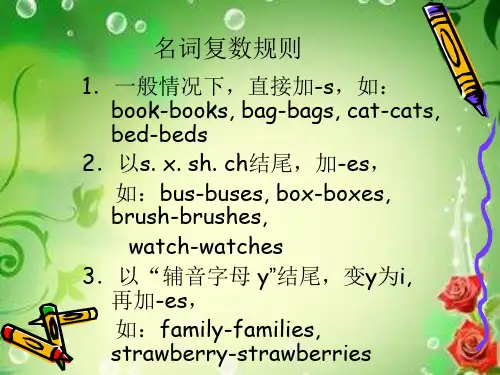
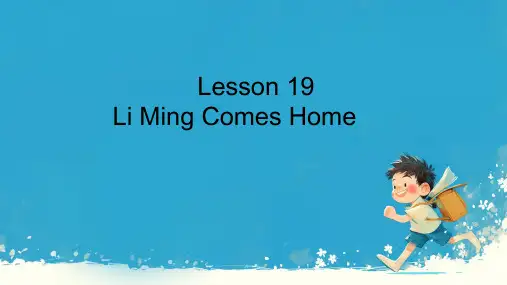
(直打版)【五年级】英语语法知识汇总(全)(word版可编辑修改)编辑整理:尊敬的读者朋友们:这里是精品文档编辑中心,本文档内容是由我和我的同事精心编辑整理后发布的,发布之前我们对文中内容进行仔细校对,但是难免会有疏漏的地方,但是任然希望((直打版)【五年级】英语语法知识汇总(全)(word版可编辑修改))的内容能够给您的工作和学习带来便利。
同时也真诚的希望收到您的建议和反馈,这将是我们进步的源泉,前进的动力。
本文可编辑可修改,如果觉得对您有帮助请收藏以便随时查阅,最后祝您生活愉快业绩进步,以下为(直打版)【五年级】英语语法知识汇总(全)(word版可编辑修改)的全部内容。
英语语法知识汇总-五年级英语语法知识汇总一、词类:1、名词这里强调两点:不可数名词都默认为单数,所以总是用is 名词复数如何加后缀:2、人称代词和物主代词人称代词:有主格和宾格之分.一般动词前用主格,动词后用宾格。
3、指示代词4、冠词有a、an、the。
a和an的区别:an用于元音音素(一般就是元音字母a、e、i、o、u)前,a用于辅音音素前.二、否定句:be动词(am、is、are)+not、情态动词can+ not、助动词(do、does) + not如何将一个肯定的陈述句改为否定句:1、看句中有无be动词,如有,直接在be动词后+ not。
2、看句中有无情态动词,如有,直接在情态动词后+ not.3、如上述二者都没有,就应用助动词+ not。
分四个步骤:(1)肯定陈述句中本来是没有助动词的,要加上去,位置在主语(某人或某物)后,动词前.(2)确定助动词用do、does,根据句中动词,动词是原形的助动词就用do,动词是第三人称单数的助动词就用does,(3)在助动词后加not。
(4)原句中动词假如发生变化就要恢复成原形。
强调一点,有some的要考虑是否要用any。
三、一般疑问句。
如何将一个肯定的陈述句改为一般疑问句:1、看句中有无be动词,如有,把be动词提到句首即可。
五年级英语语法汇总一、词类:1、名词⑴不可数名词都默认为单数,所以总是用is4、冠词有a、a和an的区别:an用于元音音素(一般就是元音字母a、e、i、o、u)前,a用于辅音音素前。
二、否定句:be动词(am、is、are)+not、情态动词can+ not、助动词(do、does) + not如何将一个肯定的陈述句改为否定句:1、看句中有无be动词,如有,直接在be动词后+ not。
2、看句中有无情态动词,如有,直接在情态动词后+ not。
3、如上述二者都没有,就应用助动词+ not。
分四个步骤:(1)肯定陈述句中本来是没有助动词的,要加上去,位置在主语(某人或某物)后,动词前。
(2)确定助动词用do、does,根据人称(不是三单)或句中动词,动词是原形的助动词就用do,人称(动词)是第三人称单数的助动词就用does,(3)在助动词后加not。
(4)原句中动词假如发生变化就要恢复成原形。
强调一点,有some的要考虑是否要用any---would like用some。
三、一般疑问句。
如何将一个肯定的陈述句改为一般疑问句:1、看句中有无be动词,如有,把be动词提到句首即可。
2、看句中有无情态动词,如有,把情态动词提到句首即可。
3、如上述二者都没有,就应把助动提到句首。
分四个步骤:(1)肯定陈述句中本来是没有助动词的,要加上去,位置在主语(某人或某物)后,动词前。
(2)确定助动词用do、does,根据人称(不是三单)或句中动词,动词是原形的助动词就用do,人称(动词)是第三人称单数的助动词就用does,(3)把助动词后提到句首。
(4)原句中动词假如发生变化就要恢复成原形。
强调一点,有some的要考虑是否要用any---would like委婉语气。
四、特殊疑问句。
表示疑问,有疑问词(在开头),回答有很多种可能。
1、一般现在时(1)一般现在时中的be动词:一般用原形:am is aream用于第一人称单数(I);is用于第三人称单数(he she it和其他人名或称谓,如:Ben his sister等);are用于第二人称单数(you)和所有复数(包括第一人称复数we、第二人称复数you;第三人称复数they和其他复数,如the children 、his parents等)。
五年级英语语法汇总一、词类:1、名词⑴不可数名词都默认为单数,所以总是用is4、冠词有a、a和an的区别:an用于元音音素(一般就是元音字母a、e、i、o、u)前,a用于辅音音素前。
二、否定句:be动词(am、is、are)+not、情态动词can+ not、助动词(do、does) + not如何将一个肯定的陈述句改为否定句:1、看句中有无be动词,如有,直接在be动词后+ not。
2、看句中有无情态动词,如有,直接在情态动词后+ not。
3、如上述二者都没有,就应用助动词+ not。
分四个步骤:(1)肯定陈述句中本来是没有助动词的,要加上去,位置在主语(某人或某物)后,动词前。
(2)确定助动词用do、does,根据人称(不是三单)或句中动词,动词是原形的助动词就用do,人称(动词)是第三人称单数的助动词就用does,(3)在助动词后加not。
(4)原句中动词假如发生变化就要恢复成原形。
强调一点,有some的要考虑是否要用any---would like用some。
三、一般疑问句。
如何将一个肯定的陈述句改为一般疑问句:1、看句中有无be动词,如有,把be动词提到句首即可。
2、看句中有无情态动词,如有,把情态动词提到句首即可。
3、如上述二者都没有,就应把助动提到句首。
分四个步骤:(1)肯定陈述句中本来是没有助动词的,要加上去,位置在主语(某人或某物)后,动词前。
(2)确定助动词用do、does,根据人称(不是三单)或句中动词,动词是原形的助动词就用do,人称(动词)是第三人称单数的助动词就用does,(3)把助动词后提到句首。
(4)原句中动词假如发生变化就要恢复成原形。
强调一点,有some的要考虑是否要用any---would like委婉语气。
四、特殊疑问句。
表示疑问,有疑问词(在开头),回答有很多种可能。
1、一般现在时(1)一般现在时中的be动词:一般用原形:am is aream用于第一人称单数(I);is用于第三人称单数(he she it和其他人名或称谓,如:Ben his sister等);are用于第二人称单数(you)和所有复数(包括第一人称复数we、第二人称复数you;第三人称复数they和其他复数,如the children 、his parents等)。